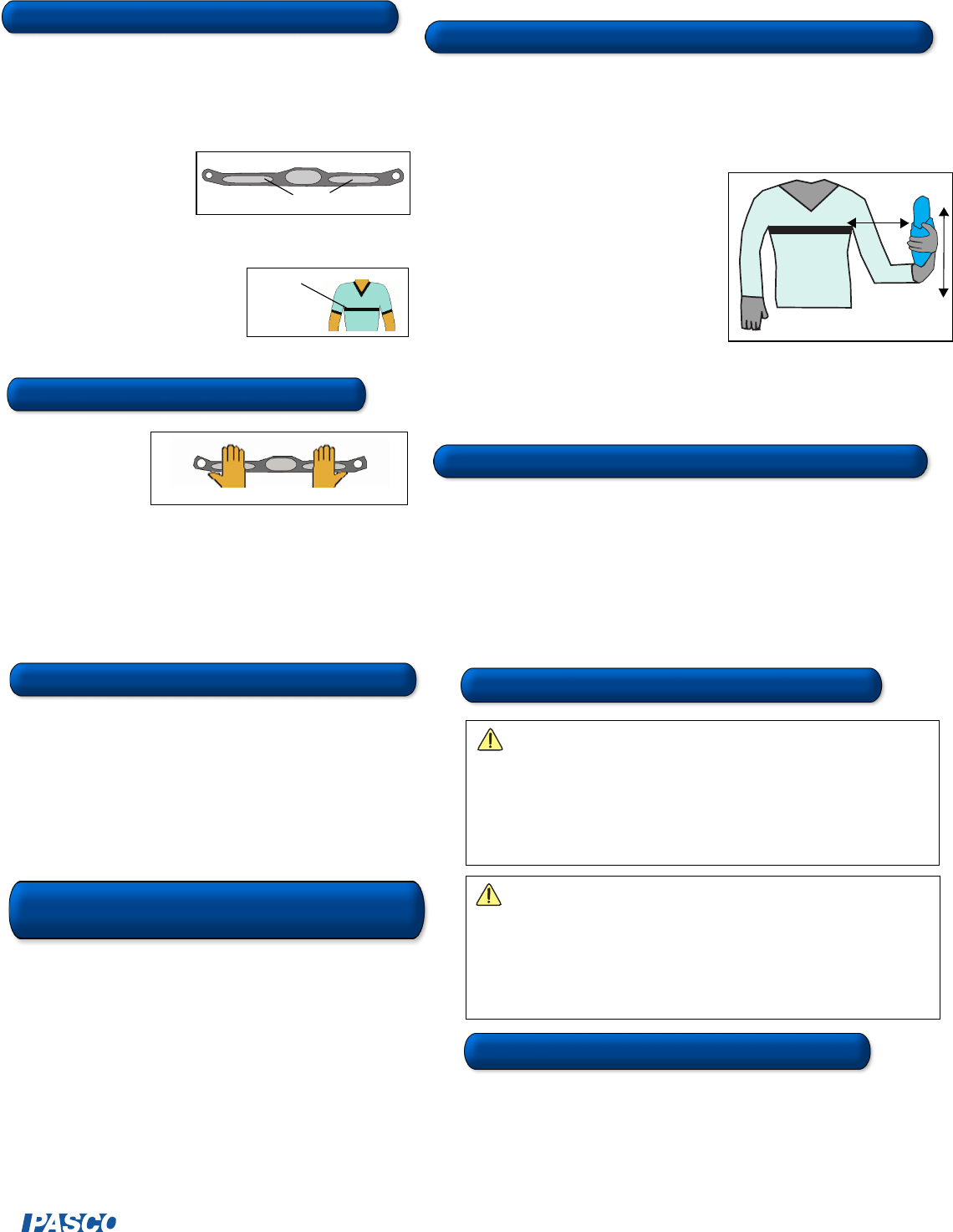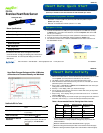
Wearing the Transmitter Belt
The Polar
®
Transmitter Belt wraps around your chest and transmits the
electrical signal from your heart beat to the Heart Rate Sensor.
(A proper
fitting belt is essential to the sensor detecting an accurate pulse reading
.)
To collect data with the Exercise Heart Rate Sensor, you must use the
transmitter belt in one of the ways described below.
a) Before using the belt, moisten
the electrodes on the underside
of the transmitter belt (Figure 1)
with water or a mild salt solution.
b) Hook one end of the
transmitter belt to the elastic strap and wrap around the upper part of your
rib cage (Figure 2).
(Note: For best accuracy, wear the belt so
that the electrode makes direct skin
contact.) c) Hook the other end of the belt
to the strap. d) Adjust the elastic strap
until the belt fits snugly around your chest.
If the belt restricts breathing, loosen the strap.
Figure 1
electrodes
transmitter
belt
Figure 2
Sensor Placement Options
The Exercise Heart Rate Sensor operates like a receiver, picking up signal transmission from
the transmitter belt. To optimize signal reception, keep the sensor in a vertical orientation on the
front of the body and within 1 meter of the transmitter belt (See “Sensor Usage Tips” on Card
2B). Keep the sensor away from computers and electrical devices. You can place the sensor in
any of the following positions (a-d below):
a) Hold in hand: Connect the sensor plug to an
Xplorer or PASPORT Extension Cable and hold
in one hand.
b) Put in a case strapped to the body: Place the
Exercise Heart Rate Sensor, Xplorer, and
Xplorer Cable inside the Xplorer Carrying Case
(PS-2099). Loop the Xplorer strap (or a waist
belt for a more snug fit) through the case. Move
the case to the front or side of the hip or waist.
Using the PASPORT Extension Cable (514-
07281), connect the sensor to the Xplorer.
c) Attach to upper arm: Place the sensor on the
left upper arm (in a vertical orientation) and hold in place with a strap, the Xplorer lanyard, or
rubberbands. Using the PASPORT Extension Cable, connect the sensor to Xplorer or a
USB Link. If using an Xplorer, place the Xplorer in a backpack or case strapped to the body.
d) Place on a table/desk: Place the sensor on a non-conductive surface, such as a wood table.
< 1 meter
Figure 4
Polar
®
is a registered trademark of Polar Electro Oy.
CARD 2A
1) With the transmitter belt on, plug the Exercise Heart Rate Sensor into a PASPORT interface
(Xplorer, USB Link, etc.).
2) In DataStudio or EZscreen, click the Start button to begin collecting data. (If using an
Xplorer, wait for the heart rate to appear in the liquid display screen before pressing the Start
button.)
Note: The light on the Exercise Heart Rate Sensor will begin flashing at the pulse rate; this
indicates adequate signal reception.
Other Belt Placement Options
a) Hold the belt with both
hands, such that the
upper palm of each
hand touches each
electrode. (With this
placement, the data quality may vary over a wide range.) b) To use around
the chest over the top of a t-shirt or tank top (in the upper rib cage area),
wrap the belt, then wet the shirt beneath the electrodes.
Figure 3
Collecting Data
®
800-772-8700 • 916-786-3800 • techsupp@pasco.com • www.pasco.com
012-08290A
CARD 2B
CAUTION: Do not place the sensor or transmitter belt around or on metal
objects, next to computer consoles, on the ground or near electrical devices,
magnets, power lines, television set, or other items emitting electromagnetic
interferences. Also, do not wear the belt or sensor for underwater activities. Using
the sensor or belt around metal or electrical devices may interfere with
measurement accuracy. Immersing the sensor in water may permanently damage
the sensor.
Transmitter Belt Maintenance
CAUTION: Excessive sensor or belt movement will affect measurement
accuracy. Erratic measurements, or large reading fluctuations, such as a drop to 0
bpm or sudden increase to 240 bpm, indicate signal loss. If signal loss occurs, rewet
the electrodes, check electrode contact (and/or tighten the belt), and move the
sensor closer to the transmitter. The most common causes of signal loss are belt
movement, inadequate electrode contact, improper sensor orientation, or too large a
distance between the transmitter and receiver.
• Always keep the sensor within one meter (3 feet) of the transmitter belt,
upright, and in a vertical orientation relative to the belt.
Avoid placing the
sensor in a horizontal or tilted orientation or on the back side of the chest.
The sensor operates best close to the belt.
• Place the sensor on a non-conductive (non-metal) surface, and away from
electrical interferences. (See “Signal Loss and Interferences” on this card.)
Do not place the sensor on metal or the ground. When you turn on the
sensor, the first few data points may be erratic as the sensor locks onto the
transmitter signal. Prior to data collection, conduct a test run to see how
much interference is present in the area.
• The Polar
®
Transmitter Belt can be washed with a mild soap solution.
Always wash and dry the belt after each use. Salt that remains on the belt
for extended periods can cause an electrical short in the transmitter and
reduce battery life.
• The Transmitter Belt contains a non-rechargeable battery and will last for
approximately 2500 hours of wear or use. The battery is not
replaceable. When the battery ceases to operate, you must purchase a
new Transmitter Belt (PS-2512).
• Heart rate, respiration, and skin temperature during exercise
• Effect of exercise training on resting and exercise heart rate (long-term studies)
• Comparison of exercise heart rate for various forms of exercise (aerobic vs.
anaerobic, high resistance vs. high repetition weight training)
• Exercise recovery rates (trained vs. untrained individuals)
• Exercise heart rate and maximum oxygen uptake
• Exercise heart rate in healthy and diseased populations
Signal Loss and Electrical Interferences
Experiment Suggestions
Tips for Using the Exercise Heart
Rate Sensor




